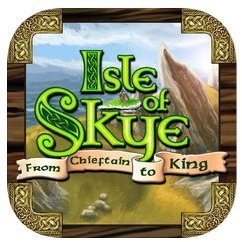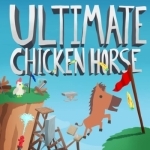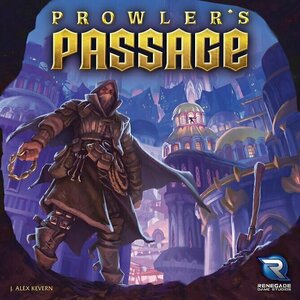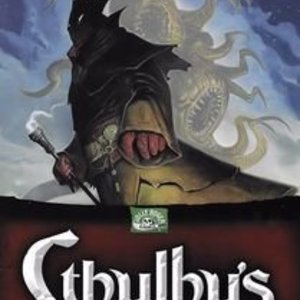
Isle of Skye
Games
App
SET YOUR PRICES, BUY, SELL, BUILD, AND MAKE CHOICES BECAUSE ONLY ONE CLAN CHIEFTAIN WILL WIN Five...
Boardgames BoardgameApp GreatGames TileLayingGames
Purple Phoenix Games (2266 KP) rated Prowler's Passage in Tabletop Games
May 19, 2021
Prowler’s Passage is a 2-player game of area majority, route building, and set collection in which players are trying to plunder the city and amass more wealth than their rival thief. Played over a series of rounds, players take turns building a passage, collecting items, and gaining influence over certain city districts. To setup the game, place the control track between the 2 players, and randomly select and place 6 board hexes as described in the rulebook. Place 3 random Achievement cards face-up next to the control board. Place the Statues and Control markers in their corresponding starting spaces, populate the board with item tiles, and each player receives 13 passage sections in their chosen color. The game is ready to begin!
On your turn, you will perform 3 actions, beginning with placing a passage. Take a passage section from your supply and place it on any pathway on the board that has an item tile on it. It is important to note that you can place your passages anywhere on the board, as long as there is an item tile in that space – your passages are not required to create a continuous, unbroken pathway. After placing your passage, collect the item tile from the pathway where you just placed your passage. Finally, each pathway is adjacent to 2 city districts. Move the Control markers for the corresponding adjacent city districts one space toward your side of the control track. Play moves on to your opponent, and the game continues as such. There are 2 scoring phases, one in the middle of the game, and the other at the game’s end. You score points for continuous passages, statues collected, sets of items gathered, city districts (if you have majority control), and fulfillment of achievement cards. All scoring items are worth different point values, so check the rulebook for the specifics of how everything is scored. At the end of the game, total up points from both scoring phases, and the player with the most points is the winner!
For a small, 2-player only game, Prowler’s Passage packs quite the punch. It is essentially a tug-of-war between players as they try to gain control of the 5 city districts and amass the most wealth. But instead of using brute strength to pull the districts in your favor, you use strategy. Every passage you put into play moves the adjacent 2 city district Control markers one space in your favor. So you have to strategize what passage placements are the most beneficial for your overall scoring, and most detrimental to your opponent. And since passages do not need to be played in a continuous line, your strategy can be more open-ended instead of limiting you to only certain future placements. Aside from gaining control of the city districts, you also receive points for collecting sets of item tokens. That’s just another layer of strategy added that takes this game to the next level. Not only do you have to decide what passage placements are best for you, you need to figure out what item tokens you want and if you are willing to risk letting go of certain district influence in order to complete an item set.
One thing that I love about Prowler’s Passage is that it is a game of open information. There are no hidden objectives, secret powers, or unknowns overall. Everything is laid out and plainly visible to both players. You can see exactly what your opponent is doing, and they can see what you are doing. So your strategy must be two-fold – putting yourself in a good position, while also attempting to stifle the progress of your opponent. Can you anticipate the strategy of your opponent, or will they be able to keep you off their trail? And as the game progresses and passage placement options dwindle, you really have to kick your strategy into overdrive to squeeze out as many points as you can before the end of the game!
The biggest drawback for me regarding this game is the actual scoring. Each city district is scored in a unique way unlike any of the other districts. So when I play, I find myself referring back to the rulebook during both mid-game and end-game scoring to check how to score everything. It’s not as intuitive as I would like, and it just slows the game down when tallying up scores. The other thing that can be a drawback is that since there are so many strategic options, it could lead to some serious AP in players. Every move affects several other factors, so you really have to be thinking deeply and in advance for each of your turns. Which is cool – I love trying to figure out the best strategy for success. But at the same time, it could bring the game to a screeching halt as one player must decide between so many options. It’s supposed to be a quick game, but overthinking is definitely a possibility.
The components of the game are nice and sturdy overall. The colors of some components don’t match perfectly, and that can lead to some confusion. The Purple city district has a nice Purple meeple, but the corresponding tile sections look more Pink to me. The Brown meeple is fine, but the city tiles have some pinkish hues. Just a little mismatching, but nothing that an edited printing can’t fix!
Overall, I would have to say that I really like Prowler’s Passage. There are many strategic options and ways to score points, and you must be able to adjust your strategy on the fly to answer back to your opponent. There is no single right strategy, and discovering different options is fun for me. Aside from the color matching in the components, and the possibilities for serious AP, this game is a great one. Enough strategy, scoring options, and player interaction to keep both players engaged, but not so difficult that you have to devote an entire game night to play one single game. I’m glad that I was able to get Prowler’s Passage in my collection, and it is high on my 2-player-only games list. Purple Phoenix Games gives it a sneaking 9/12.
Purple Phoenix Games (2266 KP) rated Cthulhu's Vault in Tabletop Games
Nov 9, 2021
Cthulhu’s Vault is a card game in which players are working together to craft an occult story, which will ultimately lead to a final battle with one of the Ancient Ones. To setup the game, each player receives an Ancient One card (kept face-down), 7 Story cards, and 2 Power tokens (one Investigator and one Cultist). Power tokens are kept face-down and are secret from other players. The remaining Power tokens are placed into two pools – either face-up or face-down as described in the rules – and a starting Story card is drawn and placed in the middle of the play area. The Power Guide card is placed off to the side, visible to players, and shows the amount of Cultist Power necessary to awaken your Ancient One during play. Select a starting player, and the game is ready to begin!
The game is broken down into two phases: the Mystery Stage and the Epic Battle Stage. The Mystery Stage begins the game, and consists of the storytelling element. On your turn, you will select a Story card from your hand and play it to the table. Here’s the catch – all players are trying to create a cohesive storyline, so you are encouraged to narrate and chain together a single story with the addition of each new Story card. After you play your Story card and tell your brief addition to the tale, you will collect a number of Power tokens as described on your played Story card, receiving Bonus tokens if applicable. The Mystery Stage continues in this fashion until a player has acquired the requisite number of Cultist Power tokens necessary to awaken their Ancient One. At the start of that turn, the player will reveal their Ancient One, and the Mystery Stage ends immediately.
Moving on to the Epic Battle Stage, there is a small bit of setup. All remaining Story cards are discarded, and Investigator cards are displayed. The player who awoke their Ancient One collects a number of Power tokens equal to the health of their creature, gathers/shuffles the Ancient One Combat Deck, and draws a hand of 3 Combat cards. All remaining players will select an Investigator to play, in order, depending on the total number of Investigator Power tokens gained during the Mystery Stage. Players will discard down to/collect a number of Power tokens to match the health of their Investigator, shuffle the Investigator Combat Deck, and draw a number of cards as dictated by their Investigator card. A Battle Order deck is created and shuffled, and will dictate the order of actions during each Epic Battle turn. The Epic Battle Stage is now ready to begin.
During the Epic Battle, a card from the Battle Order deck is revealed – either an Investigator or the Ancient One. The corresponding player will then act, playing a card from their hand, performing the action (usually Wounding the opponent), and then drawing back up to their hand limit. Play continues in this way until either the Ancient One is defeated (all Health depleted), or all the Investigators are devoured by the Ancient One. If the Ancient One is defeated, the Investigators have won! And if the Ancient One has eliminated all the Investigators, then that player wins. Either way, whomever wins is encouraged to come up with a brief epilogue to bring the overall story to an end.
So all in all, how does Cthulhu’s Vault fare? Honestly, not too great. Let’s start with the rulebook. It has some areas of serious ambiguity and confusion, which made this game kind of tough and frustrating for me to learn at first. Now that I think I’ve got it figured out, it’s ok, but that first read-through was rough. Now getting down to the actual gameplay. I can appreciate what the game is trying to do – have players create a story and then engage in their narrated battle – but the two phases of the game seem very disjointed to me. It kind of feels like you are playing 2 separate games in one. You get to have some creative fun making up a spooky story, which is then swiftly forgotten as combat ensues. There is little to no connection between the two phases, and that lack of connection makes the storytelling phase seem obsolete.
Another thing to consider when checking this game out is the group of people with whom you will play. To really get a fun, immersive story going, all players need to be willing to embrace the storytelling aspect, and get into the narrative. Requiring that type of creativity on the spot can make some players uncomfortable, and they just might not enjoy that element of the game. Let’s touch on components for a minute. I think that for the most part, the production quality is fine! The Story, Investigator, and Ancient One cards are all oversized, sturdy, and feature some neat spooky art and flavor text. The Combat cards are normal sized, and for the most part clear in their text/actions. The Power tokens are small wooden discs, and are fun to play with. The version I have is in a tin, not a cardboard box, and the tin is nice and sturdy too. Overall, good quality game.
In theory, I think Cthulhu’s Vault is a neat game. The actual execution of the gameplay doesn’t quite hit the mark for me though. The lack of connection between the two phases of the game really detracts from the overall immersion. If there were a stronger connection, perhaps I would like it more, but as it stands, it just feels like 2 separate games in one box. If you’re into storytelling games, I would consider Cthulhu’s Vault because it does provide a neat opportunity for players to craft a unified story. But the shift to the combat phase feels sudden and unrelated. Purple Phoenix Games gives this one a fiendish 5 / 12.

Blackjack 21: Blackjackist
Games
App
Play The Best Blackjack 21 free game with millions of players from all over the world! Blackjack is...
Purple Phoenix Games (2266 KP) rated Jaipur in Tabletop Games
Jun 12, 2019
Congratulations! You have become one of the most powerful traders in the Indian city of Jaipur – nobody can strike a deal quite like you! Only the best merchant will have the privilege of trading directly with the Maharajah (the city leader), and that is definitely you! Or at least, it was until a new competitor showed up and started swiping your customers… Will you give up your position willingly? Of course not! Through cunning strategy, you can prove that you are still the best trader the city has to offer – so let the competition begin!
In Jaipur, you and your opponent take turns buying, trading, and selling goods and camels for money. Out-sell your opponent in two out of three rounds to become the greatest tradesperson! Collect sets of the same goods to maximize your earnings, and use your camels wisely in trades as you try to anticipate the market trends. On your turn, you can take one of four actions: 1. Take a single good from the market, 2. Take all of the camels from the market, 3. Exchange goods/camels from your hand for multiple goods in the market, or 4. Sell goods. What will your strategy be? Monopolize the market in a specific good, or dabble in all goods? Try to anticipate your opponent’s strategy and throw a wrench in their plans, or mind your own business? No matter what you choose, strategy is the key to success in Jaipur, so make it count!
Jaipur is probably my favorite two-player game to date. The rules are simple enough, the mechanics (card drafting and set collection) are straight-forward, and it requires enough strategy to make it a fun challenge! Since it is a specifically two-player game, everything you do directly impacts your opponent. On your turn, not only are you trying to think of the best move for you to make, but you must also be thinking of what your opponent is trying to accomplish. If a couple of rounds pass and I see my opponent picking up silver goods, I can probably guess they’re hoping to make bank by selling a complete set. So do I pick up the next silver I see on my turn? Or do I cash in the set of diamonds that I’ve been secretly picking up each round? My strategy is constantly changing based on what cards appear in the market at any given time, and that is what elevates this technically simple game for me!
The only grievance for me with Jaipur has to do with the market distribution. The market cards are re-shuffled at the end of each round, and sometimes the shuffling is not balanced. I have lost many rounds because I am forced to take low-scoring goods or camels from a saturated market, only to reveal high-scoring goods for my opponent to take on their turn. Ultimately, that is not an issue with the game, but an issue with my poor card-shuffling ability. If anything, I try to see it as a strategic challenge – how can I best use these lowly goods to balance out the better cards my opponent has picked up? Nothing is a given in this game, and the market can completely change in a single turn!
If you want a quick but engaging game, look no further than Jaipur. It’s a solid two-player game that deserves more love! Purple Phoenix Games gives it a 16 / 18 (Bryan hasn’t played it yet).
https://purplephoenixgames.wordpress.com/2018/12/28/jaipur-review/

Rod Laver: An Autobiography
Book
'From my earliest tennis memories, Rod Laver stood above all others as the greatest champion our...

Badass: Making Users Awesome
Book
Imagine you're in a game with one objective: a bestselling product or service. The rules? No...

Ultimate Chicken Horse
Video Game Watch
Ever wish you were a wall-jumping, arrow-dodging, trap-setting horse, besting your animal pals in a...
multiplayer

Pimp Your Sound
Music and Entertainment
App
New ringtones and sounds for the new iOS and new devices! Please Note: You'll need iTunes to apply...

Filming the Everyday: Independent Documentaries in Twenty-First-Century China
Paul G. Pickowicz and Yingjin Zhang
Book
This cutting-edge book examines the rapidly developing scene of Chinese independent documentary,...


